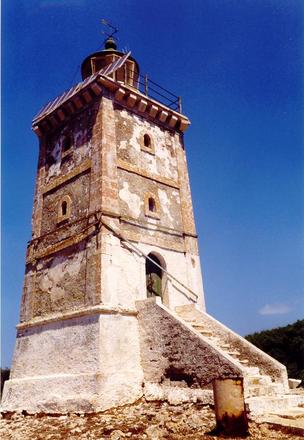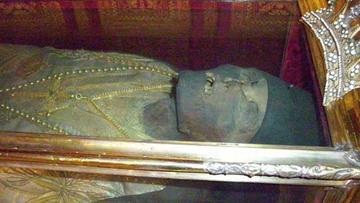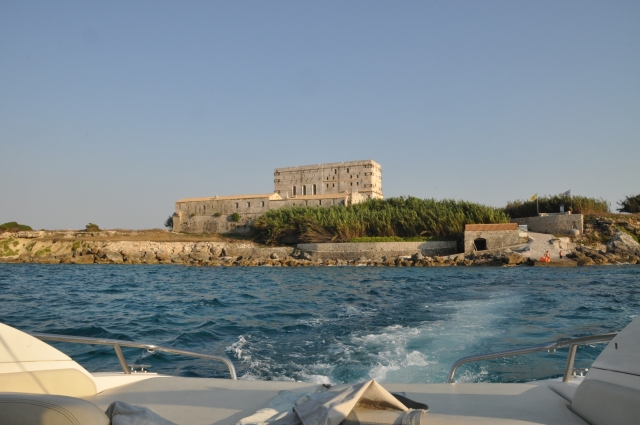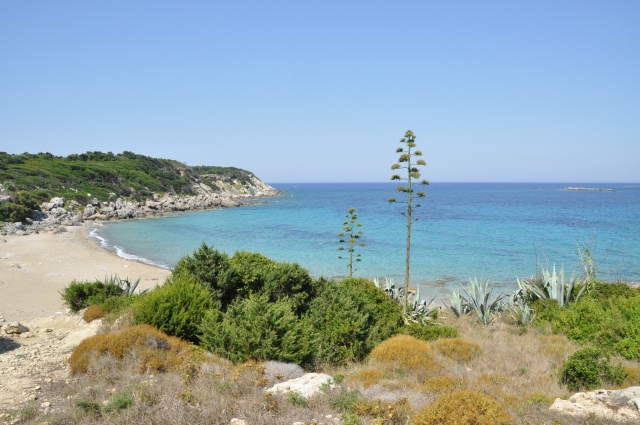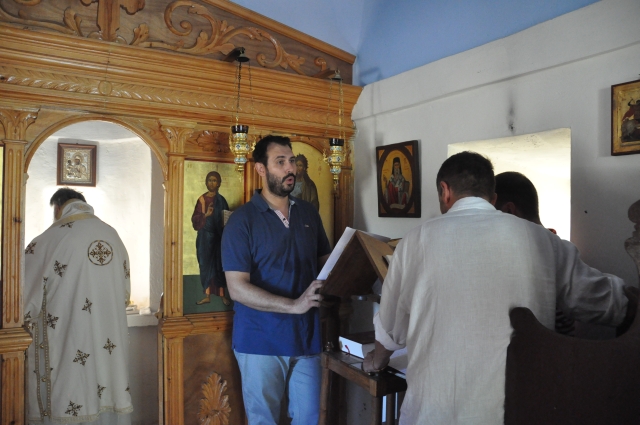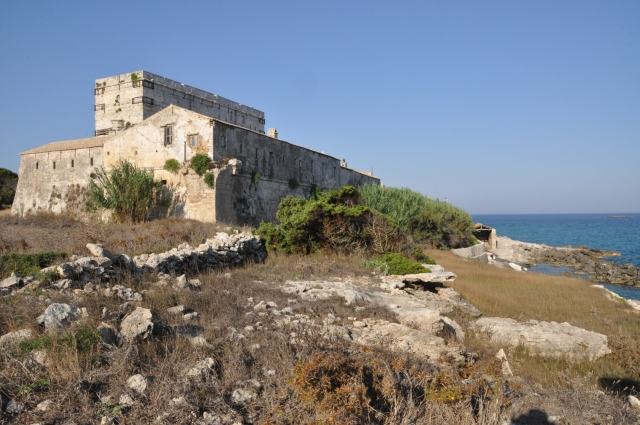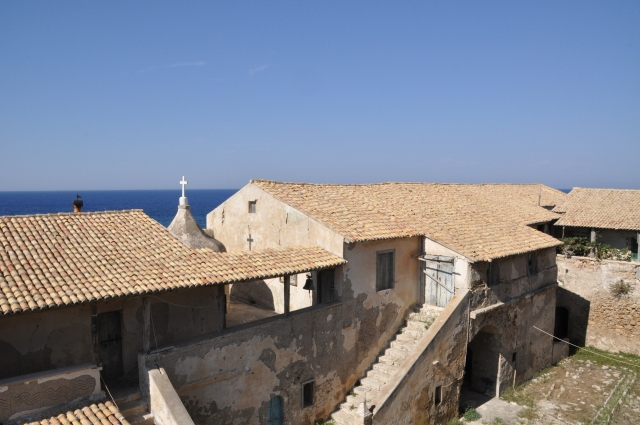The Harpies’ islands and the lord of the sea
An exceptional trip to the Strofades islands, regarded as home to the mythical Harpies, and the breathtaking beauty of an ancient hermitage that risks disappearing
A monk, the last survivor of an ancient monastery, passes away in a hot summer, while tourists populate one of the most beautiful Greek islands. Not far away, the body of a saint, saved from pirate raids, has been in exile on this very island for 300 years – perfectly preserved, it is displayed several times a day to the adoration of the faithful, then locked back in its precious case. Both – the elder monk and the saint – had taken their vows in two paradisiacal islands, now inaccessible and unknown to most, lost in the heart of the Ionian Sea.
On the largest, Stamfani, a unique, splendid monument has been a sentinel of the seas for centuries, but is now crumbling irreparably. Troubled events have surrounded this building and these characters for centuries: Orthodox metropolitan bishops and imperial shipwrecks, hideous mythological beings and tireless winds, portentous miracles and pirate raids. Until, one fine day last summer, a handful of men – including an electrician with his briefcase, an Orthodox metropolitan bishop, and young singers with their psalms – were transhipped there, in the remote Strofades islands, where beautiful birds never seen elsewhere fly in an almost impenetrable ‘jungle’. They were headed, respectively, to celebrate the liturgy of the Transfiguration with their voices, and to repair a jammed revolving mechanism, so that a beacon of navigation and civilisation would keep emitting its light and showing the route to modern sailors.
It took me a few weeks before I could put my memories in order and reflect with due detachment on what I experienced in two incredible days of August 2017: occasionally sifting, once in Italy, through essays on modern Greek architecture or hagiographies in katharevsa (the ‘pure’ language, complete with spirits and accents such as that of Plato, remained official until the time of the Colonels), looking at photos, and mulling words.
The reasons for a fascination
It all began, without me even noticing, in a late afternoon, with a still scorching sun on the sidewalks of Zakynthos, the island sung by Ugo Foscolo. At the end of a walk on the promenade, I arrived to a grandiose monastery rising before the port. On the tall portal, an inscription displayed a surprising, fascinating name for me: "Monastery of the Strofades islands". I was a little surprised, because the Strofades islands are not exactly there. I had just caught a glimpse of them, those little islands, during a slow circumnavigation around the Peloponnese a dozen years ago; I remember them far away, flat and glistening in the sky of an equally infused afternoon. That appearance on the horizon had excited me, leaving a bit of regret – I wondered if I would ever visit them.
Anyone who has studied a bit of epic poetry knows that the Strofades islands were regarded as the home of the mythical Harpies, the winged monsters and storm spirits (as their Greek name says) that attacked and threatened Aeneas and the other refugees from Troy as they paused, exhausted, during their Mediterranean crossing. Rarely, however, do the notes to the editions of the Aeneid add that the Strofades islands really exist, and that the smaller of them is called Arpya: two tiny lands (2.6 km² in total) over 40 nautical miles from Zakynthos, the southernmost inhabited Greek island in the Ionian sea.
But there is also a more personal reason why I was attracted by that name: the Strofades islands were one of the last stretches of the Hellenic archipelagos that I still had to visit. Since I arrived in Zakynthos, I asked all the shipping agencies how to get there, in vain – and unfortunately I learned that no scheduled boat, no day trip, no private boat was available for that crossing.
The body of the saint
A seller of sacred images and devotional books that I approached near the monastery, with the enviable storytelling ability that many Greeks have kept intact for millennia, finally explained to me where I was. He told me the story of Saint Dionysius, Metropolitan bishop of Aegina (another Greek island of the Aegean) and patron of Zakynthos, who took his vows in the Strofades islands. This happened in a distant time when, far from being uninhabited as today, the islands hosted up to 60-80 confraternity members – pious, industrious, and locked up in a mighty monastery-fortress.
In addition to the predictable series of miracles performed by the Saint in his life, the man finally told me of his remains, exhumed intact (and scented!) decades after death. "And now that prodigious body is near here – he concluded – the case containing it is opened every time at least a dozen faithful gather in front of it, in anxious wait. Go see it!". And, by coincidence, he added that just two days before, the last of the confraternity members, who lived in that remote monastery beyond the sea, had passed, almost ninety years old; last survivor of a series of monks that was founded at least at the time of the Byzantine emperors, perhaps even at that of Justinian.
So, after a short wait, I too witnessed the display of the relic in a side chapel of the church: in devout silence, everyone approached to kiss the miraculous body, according to the sign prescribing to venerate only the Saint’s hands and feet. Then, inside the religious premises, I found a young, very cultured layman who gave me further, precious information. The Saint has been there in Zakynthos for exactly 300 years, since August 1717 when, following the umpteenth, devastating raid of the Turks in the Strofades islands, the monks decided to secure him in the largest neighbouring island, at the time a possession of the Republic of Venice.
"If you want, I will introduce you"
The original monastery of the Strofades islands, guardian of an ancient religious tradition (it is dedicated to the "Mediatrix of All Graces" and the "Metamorphosis", as they say here, or the "Transfiguration of the Saviour"), was built in the thirteenth-century century by the will of Byzantine emperor Theodore I Lascaris, but perhaps – in a previous version – already by Justinian (sixth century AD). Since then, it has gradually depopulated: not only because of the ever increasing difficulties of an almost eremitical existence and the decline in vocations, but also because an earthquake in 1997 made the monastery unsafe and therefore uninhabitable.
My kind interlocutor showed me some pictures. I was immediately taken by the architectural beauty and singularity of the building. This is actually a fortified complex, enclosed by walls with a single entrance portal. A glorious, spectacular tower, which actually contains a Christian temple, dominates the opposite building and the sea: I saw it, high, mighty, and noble in its thirteenth-century forms, although modified by subsequent reconstructions. I was told that everything is, now as then, property of the monastery, now moved to Zakynthos, just where I was: and therefore, the Orthodox Church virtually owns the building as well as the small islands. Not just that: because of the lush vegetation, the rarity and variety of the migrant birds that stop there before their long flight to Africa, the Strofades islands are part of the Zakynthos National Marine Park, and are therefore closed not only to mass tourism, but also to summer excursions and unauthorised stays.
At this point, my face must have shown, beyond the fascination inspired by these words and images, an intimate sorrow, as I understood that I would never be able to go there. But then came the words I did not dare to hope for: "In a few days – you know? – it will be the anniversary of the Transfiguration, and the islands will be exceptionally visited by the Metropolitan bishop of Dodona, who is also the former Metropolitan bishop of Zakynthos: he will celebrate the liturgical function in a still accessible church, not far from the monastery, accompanied by some singers. If you want, I will introduce you".
I had wings on my heels when I entered the shadowed garden of today’s monastery, which preserves the tradition of the other one lying solitary beyond the sea, and I met the person who would then invite and host me in a guesthouse built some time ago on the greater of the two islands, used only in exceptional cases. His name is Chrysostom, but everyone calls him "Saint (Metropolitan) of Dodona", "Venerable", or, more familiarly, "Elder (Father)".
Kidnapped on the island
Thanks to his hospitality, and of course, that of the current Metropolitan bishop of Zakynthos, Dionysius, I spent two memorable days on the Strofades islands. First of all, the two islands are difficult to approach even physically. There is no port. The shallow waters infested with rocks and the often rough sea near the steep banks forced us to many, slow transshipments on a small boat from the patrol boat on which we arrived, which instead threw the anchor, cautiously, a hundred metres from the landing spot. In addition to the captain and his sailors, a handful of other visitors landed with me, including the technician who had to repair the lighthouse still active on the island. They, however, did not spend the night there. While I waited for my turn to land, I calmly admired, for the first time, the imposing gray building, sacred and warlike at the same time, that seems indeed the Lord of the Sea.
I thought back to what I had learned on the two islands over the few days before leaving. For millennia, those who sailed between the West and the East of the Mediterranean, and in particular between the Adriatic and the Ionian and the Aegean seas, had to face the perilous tour of the Peloponnese. Always keeping the coast in sight, but at the same time cautiously far from it, they passed between this peninsula and the Strofades islands. These are lands almost invisible and very dangerous for the hulls, as they are very low and flat, only about twenty metres high on the surface of the waves: they appear suddenly and are difficult to spot during the day (at night there is the lighthouse to signal them).
Yet their strategic location makes these islands precious: among other things, they were and are rich in drinking water. All this explains many things, from the mythical stop of Aeneas and his fellow travellers and the origins of the legend of the Harpies to the erection of a monastery that is also a fortress, as those tiny bases were coveted by those who wanted to control the sea passage. Finally, it explains not only how it was possible that dozens of people would find nourishment here (even today the islands are partially cultivated, and we were welcomed by some seasonal farmers who had been there for some weeks for the wheat harvest), but also because a large part of them is covered by what, a little jokingly, is called the "jungle".
I do not have here the time and space to tell everything I saw and did in those two days. I will just say that I have an almost enchanted memory of them, very bright, accompanied by the invaluable sense of the immense quiet of the night (no television or even cell phone signal here), amidst panoramas of absolute charm. A stay not without a small bit of uneasiness. "When we can return to Zakynthos from these islands, only He knows", told me at the table the Metropolitan bishop of Dodona, pointing the index upwards, when I asked him about our return. "You know, it depends on the conditions of the sea…".
Fortunately, I was not kidnapped forever by the Harpies. But from the beauty of that hermitage lost in the Mediterranean, without any land in sight on the horizon, yes, I was.
Heritage well worth saving
One afternoon, transgressing for the only time during the stay the recommendations of the Metropolitan bishop, I entered the abandoned monastery at my own risk, as it is crumbling and closed to visits. On the wooden stalls of the choir of the main temple, once attended by many monks, on the artistic inlays and the Byzantine eagles, a blanket of dust and a veil of spider webs stretched like a melancholic shroud.
Both inside and outside, the building is a masterpiece of architecture, so rich in history that it deserves not only not to fall into ruin (another earthquake would suffice, which is not unlikely around here: Zakynthos was totally razed to the ground in 1953), but also to be finally restored and secured as every true heritage of humanity deserves.
"So, saving this monastery is one of your life goals?", I asked the elderly Metropolitan bishop at the end of a long, intimate conversation, while the afternoon wind bent the smoke of coffee over our cups and we were waiting for the motorboat that – "if He wants it" – would bring us back to Zakynthos. "Not exactly – he corrects me – this is the sole purpose of my life".
I thought back to this confession, when a fast offshore boat finally arrived and kidnapped us, yes, from those magical islands, which quickly flattened and were reabsorbed by the back of the sea, to fade away like a dream in the shadows of the evening. Who knows when, and if ever, I will see them again.
Over the past years, accurate studies and surveys have been made on the monastery of the Strofades islands, and there is already a technical project for its restoration. However, saving this archaeological monument from certain death and making it accessible in the future, even to those who have not been as lucky as I was, requires substantial funds. Greece has other problems and expenses to face now, struggling with its terrible crisis. But Europe, who knows, could take this opportunity to show that it has also a soul, and send a good signal to Greek citizens and to the millions of summer visitors of the Hellenic islands, financing the works and making these lost jewels accessible again – before the Harpies take them away forever.
Featured articles
- Take part in the survey
The Harpies’ islands and the lord of the sea
An exceptional trip to the Strofades islands, regarded as home to the mythical Harpies, and the breathtaking beauty of an ancient hermitage that risks disappearing
A monk, the last survivor of an ancient monastery, passes away in a hot summer, while tourists populate one of the most beautiful Greek islands. Not far away, the body of a saint, saved from pirate raids, has been in exile on this very island for 300 years – perfectly preserved, it is displayed several times a day to the adoration of the faithful, then locked back in its precious case. Both – the elder monk and the saint – had taken their vows in two paradisiacal islands, now inaccessible and unknown to most, lost in the heart of the Ionian Sea.
On the largest, Stamfani, a unique, splendid monument has been a sentinel of the seas for centuries, but is now crumbling irreparably. Troubled events have surrounded this building and these characters for centuries: Orthodox metropolitan bishops and imperial shipwrecks, hideous mythological beings and tireless winds, portentous miracles and pirate raids. Until, one fine day last summer, a handful of men – including an electrician with his briefcase, an Orthodox metropolitan bishop, and young singers with their psalms – were transhipped there, in the remote Strofades islands, where beautiful birds never seen elsewhere fly in an almost impenetrable ‘jungle’. They were headed, respectively, to celebrate the liturgy of the Transfiguration with their voices, and to repair a jammed revolving mechanism, so that a beacon of navigation and civilisation would keep emitting its light and showing the route to modern sailors.
It took me a few weeks before I could put my memories in order and reflect with due detachment on what I experienced in two incredible days of August 2017: occasionally sifting, once in Italy, through essays on modern Greek architecture or hagiographies in katharevsa (the ‘pure’ language, complete with spirits and accents such as that of Plato, remained official until the time of the Colonels), looking at photos, and mulling words.
The reasons for a fascination
It all began, without me even noticing, in a late afternoon, with a still scorching sun on the sidewalks of Zakynthos, the island sung by Ugo Foscolo. At the end of a walk on the promenade, I arrived to a grandiose monastery rising before the port. On the tall portal, an inscription displayed a surprising, fascinating name for me: "Monastery of the Strofades islands". I was a little surprised, because the Strofades islands are not exactly there. I had just caught a glimpse of them, those little islands, during a slow circumnavigation around the Peloponnese a dozen years ago; I remember them far away, flat and glistening in the sky of an equally infused afternoon. That appearance on the horizon had excited me, leaving a bit of regret – I wondered if I would ever visit them.
Anyone who has studied a bit of epic poetry knows that the Strofades islands were regarded as the home of the mythical Harpies, the winged monsters and storm spirits (as their Greek name says) that attacked and threatened Aeneas and the other refugees from Troy as they paused, exhausted, during their Mediterranean crossing. Rarely, however, do the notes to the editions of the Aeneid add that the Strofades islands really exist, and that the smaller of them is called Arpya: two tiny lands (2.6 km² in total) over 40 nautical miles from Zakynthos, the southernmost inhabited Greek island in the Ionian sea.
But there is also a more personal reason why I was attracted by that name: the Strofades islands were one of the last stretches of the Hellenic archipelagos that I still had to visit. Since I arrived in Zakynthos, I asked all the shipping agencies how to get there, in vain – and unfortunately I learned that no scheduled boat, no day trip, no private boat was available for that crossing.
The body of the saint
A seller of sacred images and devotional books that I approached near the monastery, with the enviable storytelling ability that many Greeks have kept intact for millennia, finally explained to me where I was. He told me the story of Saint Dionysius, Metropolitan bishop of Aegina (another Greek island of the Aegean) and patron of Zakynthos, who took his vows in the Strofades islands. This happened in a distant time when, far from being uninhabited as today, the islands hosted up to 60-80 confraternity members – pious, industrious, and locked up in a mighty monastery-fortress.
In addition to the predictable series of miracles performed by the Saint in his life, the man finally told me of his remains, exhumed intact (and scented!) decades after death. "And now that prodigious body is near here – he concluded – the case containing it is opened every time at least a dozen faithful gather in front of it, in anxious wait. Go see it!". And, by coincidence, he added that just two days before, the last of the confraternity members, who lived in that remote monastery beyond the sea, had passed, almost ninety years old; last survivor of a series of monks that was founded at least at the time of the Byzantine emperors, perhaps even at that of Justinian.
So, after a short wait, I too witnessed the display of the relic in a side chapel of the church: in devout silence, everyone approached to kiss the miraculous body, according to the sign prescribing to venerate only the Saint’s hands and feet. Then, inside the religious premises, I found a young, very cultured layman who gave me further, precious information. The Saint has been there in Zakynthos for exactly 300 years, since August 1717 when, following the umpteenth, devastating raid of the Turks in the Strofades islands, the monks decided to secure him in the largest neighbouring island, at the time a possession of the Republic of Venice.
"If you want, I will introduce you"
The original monastery of the Strofades islands, guardian of an ancient religious tradition (it is dedicated to the "Mediatrix of All Graces" and the "Metamorphosis", as they say here, or the "Transfiguration of the Saviour"), was built in the thirteenth-century century by the will of Byzantine emperor Theodore I Lascaris, but perhaps – in a previous version – already by Justinian (sixth century AD). Since then, it has gradually depopulated: not only because of the ever increasing difficulties of an almost eremitical existence and the decline in vocations, but also because an earthquake in 1997 made the monastery unsafe and therefore uninhabitable.
My kind interlocutor showed me some pictures. I was immediately taken by the architectural beauty and singularity of the building. This is actually a fortified complex, enclosed by walls with a single entrance portal. A glorious, spectacular tower, which actually contains a Christian temple, dominates the opposite building and the sea: I saw it, high, mighty, and noble in its thirteenth-century forms, although modified by subsequent reconstructions. I was told that everything is, now as then, property of the monastery, now moved to Zakynthos, just where I was: and therefore, the Orthodox Church virtually owns the building as well as the small islands. Not just that: because of the lush vegetation, the rarity and variety of the migrant birds that stop there before their long flight to Africa, the Strofades islands are part of the Zakynthos National Marine Park, and are therefore closed not only to mass tourism, but also to summer excursions and unauthorised stays.
At this point, my face must have shown, beyond the fascination inspired by these words and images, an intimate sorrow, as I understood that I would never be able to go there. But then came the words I did not dare to hope for: "In a few days – you know? – it will be the anniversary of the Transfiguration, and the islands will be exceptionally visited by the Metropolitan bishop of Dodona, who is also the former Metropolitan bishop of Zakynthos: he will celebrate the liturgical function in a still accessible church, not far from the monastery, accompanied by some singers. If you want, I will introduce you".
I had wings on my heels when I entered the shadowed garden of today’s monastery, which preserves the tradition of the other one lying solitary beyond the sea, and I met the person who would then invite and host me in a guesthouse built some time ago on the greater of the two islands, used only in exceptional cases. His name is Chrysostom, but everyone calls him "Saint (Metropolitan) of Dodona", "Venerable", or, more familiarly, "Elder (Father)".
Kidnapped on the island
Thanks to his hospitality, and of course, that of the current Metropolitan bishop of Zakynthos, Dionysius, I spent two memorable days on the Strofades islands. First of all, the two islands are difficult to approach even physically. There is no port. The shallow waters infested with rocks and the often rough sea near the steep banks forced us to many, slow transshipments on a small boat from the patrol boat on which we arrived, which instead threw the anchor, cautiously, a hundred metres from the landing spot. In addition to the captain and his sailors, a handful of other visitors landed with me, including the technician who had to repair the lighthouse still active on the island. They, however, did not spend the night there. While I waited for my turn to land, I calmly admired, for the first time, the imposing gray building, sacred and warlike at the same time, that seems indeed the Lord of the Sea.
I thought back to what I had learned on the two islands over the few days before leaving. For millennia, those who sailed between the West and the East of the Mediterranean, and in particular between the Adriatic and the Ionian and the Aegean seas, had to face the perilous tour of the Peloponnese. Always keeping the coast in sight, but at the same time cautiously far from it, they passed between this peninsula and the Strofades islands. These are lands almost invisible and very dangerous for the hulls, as they are very low and flat, only about twenty metres high on the surface of the waves: they appear suddenly and are difficult to spot during the day (at night there is the lighthouse to signal them).
Yet their strategic location makes these islands precious: among other things, they were and are rich in drinking water. All this explains many things, from the mythical stop of Aeneas and his fellow travellers and the origins of the legend of the Harpies to the erection of a monastery that is also a fortress, as those tiny bases were coveted by those who wanted to control the sea passage. Finally, it explains not only how it was possible that dozens of people would find nourishment here (even today the islands are partially cultivated, and we were welcomed by some seasonal farmers who had been there for some weeks for the wheat harvest), but also because a large part of them is covered by what, a little jokingly, is called the "jungle".
I do not have here the time and space to tell everything I saw and did in those two days. I will just say that I have an almost enchanted memory of them, very bright, accompanied by the invaluable sense of the immense quiet of the night (no television or even cell phone signal here), amidst panoramas of absolute charm. A stay not without a small bit of uneasiness. "When we can return to Zakynthos from these islands, only He knows", told me at the table the Metropolitan bishop of Dodona, pointing the index upwards, when I asked him about our return. "You know, it depends on the conditions of the sea…".
Fortunately, I was not kidnapped forever by the Harpies. But from the beauty of that hermitage lost in the Mediterranean, without any land in sight on the horizon, yes, I was.
Heritage well worth saving
One afternoon, transgressing for the only time during the stay the recommendations of the Metropolitan bishop, I entered the abandoned monastery at my own risk, as it is crumbling and closed to visits. On the wooden stalls of the choir of the main temple, once attended by many monks, on the artistic inlays and the Byzantine eagles, a blanket of dust and a veil of spider webs stretched like a melancholic shroud.
Both inside and outside, the building is a masterpiece of architecture, so rich in history that it deserves not only not to fall into ruin (another earthquake would suffice, which is not unlikely around here: Zakynthos was totally razed to the ground in 1953), but also to be finally restored and secured as every true heritage of humanity deserves.
"So, saving this monastery is one of your life goals?", I asked the elderly Metropolitan bishop at the end of a long, intimate conversation, while the afternoon wind bent the smoke of coffee over our cups and we were waiting for the motorboat that – "if He wants it" – would bring us back to Zakynthos. "Not exactly – he corrects me – this is the sole purpose of my life".
I thought back to this confession, when a fast offshore boat finally arrived and kidnapped us, yes, from those magical islands, which quickly flattened and were reabsorbed by the back of the sea, to fade away like a dream in the shadows of the evening. Who knows when, and if ever, I will see them again.
Over the past years, accurate studies and surveys have been made on the monastery of the Strofades islands, and there is already a technical project for its restoration. However, saving this archaeological monument from certain death and making it accessible in the future, even to those who have not been as lucky as I was, requires substantial funds. Greece has other problems and expenses to face now, struggling with its terrible crisis. But Europe, who knows, could take this opportunity to show that it has also a soul, and send a good signal to Greek citizens and to the millions of summer visitors of the Hellenic islands, financing the works and making these lost jewels accessible again – before the Harpies take them away forever.

